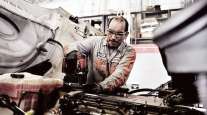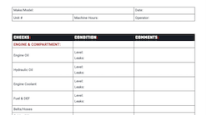5 Questions With Rig Runner's Jay Rincker

[Find the latest in equipment & maintenance: Explore this quarter's issue of Calibrate]
Jay Rincker joined Rig Runner as its director of maintenance and asset management earlier this year. Prior to Rig Runner, Rincker was the director of maintenance with Jetco Delivery. As an experienced technician and director, he shared some of his thoughts about the trucking industry as well as the repair and maintenance sector.
“I believe everyone wants to win or succeed,” Rincker said. “My job is to listen to the technicians and give them the tools to make that happen.”
What are your top maintenance-related challenges, and how are you working to overcome them as director of maintenance?
My top challenge is getting the equipment scheduled in the shop for repairs as our world has been turning into a more “as needed” and “on time” delivery. The best way I have been able to overcome this is working hand-in-hand with the dispatch team to make everyone aware of what is going to be available for them to use on the planned routes. Our next issue is making sure that we have all the parts that will be needed for the services or repairs. We are able to overcome this by making sure that we stock the parts that will be needed for the specific service or repairs before the unit comes into the shop.
More Q2 Calibrate
►Standard Sought for Brake Lining Classification
►Freeze: Participating in the Right to Repair Debate
►Fleets Weigh Lift Equipment
►5 Questions With Rig Runner's Jay Rincker
►Baxter: New Oil Standard Will Help Fleets
►TMC Corner: The Evolution of Tractor-Trailer Connectivity
Explore the Issue!
With the emergence of electric vehicle fleets and several advances in maintenance technology, how does your team navigate through these innovations to operate more efficiently?
As of yet we have not had experience with the EV units. This is a direction that the industry is heading and one that we all will need to be trained on. We must leverage our technology as much as we can to help us make solid decisions with repairs and with service intervals. The days of just having one preventative maintenance item for everything has passed. We continue to evaluate how our equipment is being used so we can have our equipment on the road as much as possible, while keeping safety a top priority.
What are the most pressing procurement issues you’re encountering and how have those concerns been remedied? How do you cultivate your OEM and aftermarket partner relationships?
One of the biggest challenges for us in 2022 has been availability of parts or purchasing equipment. We have built strong relationships with our OEM partners and our vendors. We have seen our partnership with the aftermarket team grow stronger as they have been able to step up and provide great value for us.
What is your philosophy in leading your group of technicians?
My philosophy has changed over the years as the technicians have continued to evolve. The main thing I do is ask the team what they need to succeed, I make sure that we understand that there are want to’s and have to’s and they are not the same.
The first thing we work on are the have to’s and then move on to the want to’s. We have to have to correct software to work on the unit and do a proper diagnosis and repair. However, it might be more cost-effective for us to send a unit to a vendor for repairs as the ROI to purchase the software is not where we would like to have it.
Want more news? Listen to today's daily briefing above or go here for more info
How do you envision the fleet maintenance and repair environment for commercial trucks evolving in the next five to 10 years?
The next five to 10 years is going to be another leap forward for our industry; of course there will be some challenges, we had a learning curve when regeneration came to our field. In the beginning, we stumbled but the industry picked itself up by doing the training along with improvements to the system. We are now all better for it. We will go through this again as the emission systems continue to improve with higher standards.
We will see electric vehicles, natural gas vehicles and other hybrids make their way into the industry. There will be challenges on the technician side as the vast majority will be experiencing something new. We are naturally afraid of what we do not know, or as I like to call it “the dark.” Those fleets that embrace the challenges of the new world have the opportunity to reduce costs and downtimes of units. We have seen how automatic transmissions have gained a stronger footprint on our industry and I do not see that changing anytime soon. I also see electric vehicles really pushing their way in to the field we have already seen this with companies preordering units. We have seen the industry change over as it finds the best way to do what is needed and I see no reason believe that we will not continue on this path.





